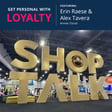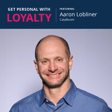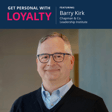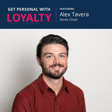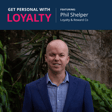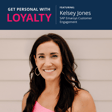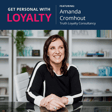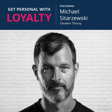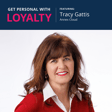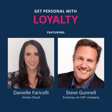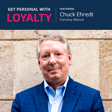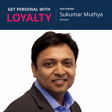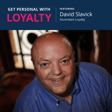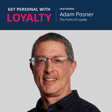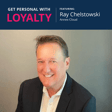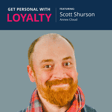Become a Creator today!Start creating today - Share your story with the world!
Start for free
00:00:00
00:00:01

Using Data to Identify and Reward Customers (ft. Dave Mansfield)
In this episode, we speak with Dave Mansfield, Executive Vice President of Analytics at Tandem Theory. We explore the hidden power of data and how brands can utilize zero and first-party data to identify and reward valuable customers. Tune in to learn more about using data to enhance customer loyalty.
Transcript
Dave Mansfield's Analytics Journey
00:00:10
Speaker
Get personal with loyalty where we're discussing using loyalty to deliver personalized relevant customer experiences. Hello everybody, welcome to the next episode of get personal with loyalty. Today I'm here with Dave Mansfield, the EVP of analytics for tandem theory. Welcome Dave.
00:00:31
Speaker
Many, many thanks for having me today. I appreciate the honor and the privilege of joining you today. Thank you. So excited to have you. I love the topic of analytics. Before we dive into that, though, why don't you take a couple of minutes and give us a bit of your background and how you ended up in analytics and in this fun space that we call loyalty. Yeah, I'm dating myself here, but it kind of goes back 30 plus years and it really started with, I would say, a barcode.
00:00:57
Speaker
Back in the early 90s, I joined a company that was putting barcodes on print pieces.
Focus on ROI and Optimization
00:01:02
Speaker
If you remember the old mail that you get in your mailbox on Tuesdays and Wednesdays, we were putting barcodes early on in those days to track and measure ROI for some of the media spend for our clients. At a very early age, I was into ROI and making our clients' investments accountable and more importantly, measurable.
00:01:22
Speaker
Then on top of that, it's all about optimization. I got into the world of CRM and loyalty and using these tools to build transactions, to build comp growth for our clients year over year through a simple barcode. That's where it all started for me. That's my entree into the world of data, the world of measurement, the world of bringing data pieces together to our data curiosity.
00:01:49
Speaker
to make sure that our marketing efforts are impactful, that are driving ROI. You can basically, at the end of the day, assign a dollar to every marketing action that you do. So that's kind of where I got my start and how I've been able to enjoy data ever since.
00:02:04
Speaker
That's pretty quick. Hopefully that was clear, but that's kind of how I started. My love of data continues to this day. I don't want to do anything else. I don't want to manage. I don't want to lead. I want to lead by example, meaning that I like to get my hands into the data. I like to work with the teams, collaborate with the team, find measurement solutions with the team. If I can get my hands dirty in the data, that makes me happy. Love it. I love that there are people like you.
00:02:33
Speaker
Love data, but I'm not capable of doing it to the extent that you do. And so significant because I've been around, I think as long as you have.
00:02:43
Speaker
and have seen a lot of changes and certainly back then their loyalty as an example was just getting started. It was a lot of money being spent on advertising and not much of that was able to be tracked. For the audience here that may be listening that's younger.
Challenges in Early CRM Efforts
00:03:01
Speaker
That's a pretty significant, what you guys were doing was pretty significant and being able to or being conscious enough to have a call to action.
00:03:10
Speaker
That point in time to be able to track how the efforts were working. Yeah, and sometimes that was our only way of doing it, right? Like CRM or one to one communications was collecting that data manually. I mean back in the day we were doing manual collection of.
00:03:24
Speaker
Coupons and receipts, you know, and tying that receipt data in fact the individuals and then using that in our CRM effort. So this was before the day, you know, even though, you know, loyalty programs for a lot of our clients, you know, having the ability to track data down to an individual level. We really had to kind of get scrappy back in the day on 100% for sure.
00:03:44
Speaker
For sure. So fast forward a few decades, I guess.
Role at Tandem Theory: Making Marketing Measurable
00:03:49
Speaker
Now you're with tandem theory. For those that aren't familiar with tandem theory, what is it that you guys do and what is your role there and how are you helping clients? Yeah, so my role is kind of young response for kind of building all the measurement and analytical solutions across our clients' activities.
00:04:08
Speaker
Whether that's in, like you said, we're kind of 20, 30 years later now, the world's got a lot more complicated in terms of data. It's got a lot more challenging, but a lot more fun, right? The world's evolved.
00:04:19
Speaker
And so my goal with our team is just to make sure that, you know, like I mentioned earlier, we're making all our marketing actions accountable, right? We're able to measure it, quantify it, tell us how it's working, what is working, what is not working, where it's working, where it's not working, and really kind of inform and help, whether it's our team, whether it's our media teams or strategy teams. What is it that's working? Where do we need to look into, you know, tuning things, fine tuning things? And a lot of times about where do we need to test further, right?
00:04:46
Speaker
A big proponent of test and learn, you know, constantly filling that testing pipeline so that we can always have, you know, levers that we can pull right that's a key in this day and age is knowing what works and what doesn't work, whether it's for an individual or for a certain segment of your audience or customer base.
00:05:01
Speaker
That's kind of key for us too as our client. You might have a current period where you have sales challenges. Our job is to help you inform what are some of those levers that you can pull that whether it's a short-term or a long-term application that can drive those incremental or those comp results. Our job is across all the different channels, whether it's CRM, whether it's loyalty, whether it's across traditional media or digital media,
00:05:26
Speaker
We're kind of in charge of making sure we manage the analytics around all those different programs. And the other thing I would kind of say is we've kind of grown into two as a kind of one of, you know, you know, it's only part of the responsibility is that with all this new data, you know, it's come, you know, over the last 10, 15, 20 years.
Data Stewardship and Accuracy
00:05:42
Speaker
comes a lot more data problems, right? So we find ourselves too, kind of filling the role of data stewards, you know, and that's become a big part of our responsibility is kind of making sure that when you do have a lot more data, when you do have a lot more partners that you rely on for that data,
00:05:57
Speaker
the accuracy is of the utmost importance, right? So it's really key that we spend a little bit of time too on the data stewardship side to make sure that we're detecting whether it's anomalies in data issues and gaps in the data and just making sure, you know, that the data is, you know, as accurate as it possibly can be that we're telling the right story, the right set of results every time. I think that's another key that I've kind of learned over the particular the last five or 10 years, I would say. Amazing point. And it was so, so let's,
00:06:28
Speaker
Table that for a second. I definitely want to dig into data stewardship. But I think let's all have a frame of reference for how the conversation is going to continue.
00:06:37
Speaker
tandem theory am I accurate in saying that you guys are agency that is supporting clients across believe you said multiple strategies multiple channels. So I tend to think loyalty as the end game but I also get very programmatic just because where I sit you guys are much broader than that. And in supporting you mentioned media you mentioned
00:06:59
Speaker
other digital channels so whatever marketing efforts are lovers of brand could pull to drive more revenue longer customer lifetime value etc those are the types of things that you guys are getting your hands into and helping your clients with. Yeah thousand percent yeah we can theory yes is a full service,
00:07:21
Speaker
you know analytically driven agency. Right. I mean we in the last four or five years we've kind of built up our capabilities to be that full service. Right. And so we kind of think of loyalty in a more probably holistic sense. You know I kind of think of it as holistic right. It does doesn't have to be
00:07:38
Speaker
a loyalty platform that you sit on top of your POS system that assigns points and rewards. You can be other levers that you can dial up. I think of loyalty as part of your CRM engine. What are the things that I can do to communicate to you, whether that's through a platform, whether it's through your communications one-on-one, whether it's e-mail, text, etc, or whether that's online through your website, through some of the online channels that I can personalize to you. I think of loyalty broadly in that respect.
Measuring Marketing Effectiveness with Data
00:08:06
Speaker
And that's definitely what we're responsible for, right? Is kind of to your point dialing up those channels or dying up those avenues that we can use to get our communications out right to create those actions that we want. And you can't be effective if you're not looking at the data.
00:08:20
Speaker
Yeah, yeah, the data drives everything and the data helps you measure on the back end, right? So it's a constant loop of looking at the data. What is it telling us? What do we need to do? What do we need to test? And then constantly using testing control, for example, to always measure is it generating incremental lift? We're big about lift and did we see lift from these actions, right?
00:08:42
Speaker
We're big into using single data is great and other tools online for some of the media platforms are great, but at the end of the day, our clients want to know, did it drive visits? Did it drive sales for me? That's what they're responsible for at the end of the day, and that's what they're looking for us to deliver.
00:08:59
Speaker
As you're talking and I'm thinking about this there's what you just mentioned the what did this marketing effort do for me. But then there's the data that's being collected that is about the customer. So it's.
00:09:15
Speaker
first party, zero party data, things we always talk about, but it's how the customer has behaved, what their interactions are. And you've got to utilize that, right? In order to actually increase results. Maybe chat a little bit about that. Like how do you guide clients from that perspective?
First-Party Data and Customer Insights
00:09:32
Speaker
Data is important to collect and how do you use that data to then increase the results in these different activities?
00:09:42
Speaker
Yeah, great question. We are very lucky. A lot of our clients have really rich customer tie transactional data, meaning that for a lot of our clients, nearly 100% of their business, 100% of their revenue, 100% of their transactions and visits, we have a lot of retail clients and restaurant clients, are tied to an individual. So first party data is probably the biggest key for us, right?
00:10:07
Speaker
And whether or not that first party data that comes through via, you know, you have to have that data, your brand that has to have, you know, your email address, your phone number, your, your name, address and things like that. A lot of our clients have that richness of data, first party data. So we know exactly who you are and what you've done, you know.
00:10:26
Speaker
But secondly, it could be brands that leverage other tools, whether it's loyalty as a data collection point, whether it's CDPs as another kind of enrichment and ability to kind of tie and identity graph your customers together and kind of create that golden record. We kind of leverage all those tools, right? Because what
00:10:45
Speaker
we get the best results from is when we have that individual data, right? So that first party data you mentioned is really key, right? You may use third party data and other overlays, whether it's your zero party data, your second party data and all that kind of fancy stuff. But the key to that starting point is what first party data are available, right? Because then you can create not only the individualness, right?
00:11:07
Speaker
and understand individually do what, but if you need to understand cohorts and segments and things like that, it allows for that flexibility and analytics to understand who is driving your business from a descriptive perspective. What are the opportunities in the business? What are maybe some of the segments that you might see that are not driving loyalty or driving our comps or maybe this particular group of customers is the group that is causing us to have those sales challenges.
00:11:36
Speaker
Having that first party data is key because it allows you to be able to go in there and create those individuals as well as individual guest cohorts or segments that you can use to describe to C-suite or to your clients. These are the people who we need to target that we need to take action on, those kinds of things.
00:11:57
Speaker
Thank you for that. As you're talking and you're focused on this first party data, I end up in conversations with people a lot and we talk about data and the ability to collect unlimited number of attributes.
Too Much Data: Challenges for Brands
00:12:10
Speaker
And there's some cool technology now that allows you to progressively profile customers. So we have clients that are serving up
00:12:17
Speaker
different questions every time somebody logs in that are fun and interactive which is fun and exciting but as I'm listening to you thinking that maybe that's causing almost more challenges for brands than the good it's helping because then you end up with so much data that what are you able to do with it then and does that become just
00:12:40
Speaker
almost a burden or how do you guide clients there? Because I like the fact that you started with first party data is important to work with that. And then is it then once you establish that and you're doing good things from there, then you can add on those other kinds of cool and exciting ways to collect more.
00:13:01
Speaker
How do you guide people? We're definitely always looking for ways to enhance that data. We talked about third-party data, whether it's, for example, demographic data. An example, still a lot of clients love to understand, what does my customer look like? What does my guest look like in terms of demographic? That's still a big thing. Clients like to create segmentation, whether it's demographic segmentation, transactional segmentation, or some hybrid method of both.
00:13:29
Speaker
We still layer on demographics. The other thing you know kind of to your point about you know fun is yeah I think it's fun obviously but we really kind of rely on metrics that matter right like what are the lagging indicators what are the leading indicators that best help us understand and predict right what is going to help us say
00:13:47
Speaker
This is something that tells us that we might have a sales challenge 90 days from now, right? So to your point about like a survey or something, right? We do do surveys in a couple of forms. Number one, we do a lot of voice to guest data surveys, right? So that helps us kind of put perspective to maybe some of the whys, right? Like what is in the mind of the consumer? What are they challenged with today?
00:14:05
Speaker
We do keep, for a lot of our clients, use that voice of the guest to keep our finger on the pulse of what might be happening from a macro perspective, what might be happening from a day in the life perspective. What are the challenges that they're faced with? Because we always hear these stories, these headwinds out there, whether it's inflation, this or that. We always try to keep our finger on the pulse of the mind of our customer.
00:14:28
Speaker
Secondly, we might do other surveys that are ad hoc to address a certain business problem or a new concept or testing things as well. So we use it for concept testing as well. So we're always saying like, how would you respond to this? Or what if we change something, our loyalty program to that? How would you respond? Any caveats, any thoughts that you have around this? Whether it's, we did a survey back in the day for one brand where we just asked them, I'll write, say,
00:14:55
Speaker
What if we reduced the frequency or the cadence and the length of time of the expiration for these rewards, and got a feel for them to say, hey, what would be tolerable? Because what we found in that day was that the shorter the expiration window, we could compress purchase cycles, we could create better incrementality,
00:15:16
Speaker
Rather than putting like a 90 day expiration. So at that point for testing things that so we went to the voice of the customer just say what do you think about this right? You know, would this be a turn off that kind of thing? So we really leverage that data.
00:15:29
Speaker
to give us additional guidance and insights into what might be happening, what we see in historical transactional data, and to help us adapt and think about our strategies, whether it's CRM strategies, whether it's loyalty strategies or tuning, that kind of thing, or testing. We can get a lot of good testing ideas sometimes, like the expiration date, we took that, we went in and worked at testing of different expiration windows and found an optimal timeframe,
00:15:56
Speaker
that we heard from our guests that that was ideal. It was okay. Don't give me a 10-day expiration, but I'm okay with this. Just listening to their feedback, following up with the market testing versus controls, we're able to come up with a more optimized program or set of expiration that accomplished two objectives, continue to make the guest happy and that they were able to redeem the rewards. Secondly, it was able to deliver the action that the client wanted in terms of driving incremental results.
00:16:27
Speaker
So again, we kind of focus on, you know, as I call it, the metrics that matter, right? You know, there is a lot out there, but you just, you know, you just have to get through what am I trying to drive here, right? And metrics can help me understand, you know, how I can either do it better, identify the testing opportunities, or how did something do so.
00:16:47
Speaker
And the metrics that matter wrote that down. Do you have metrics that matter that are similar or core that most companies would need to be watching.
00:17:00
Speaker
I'm sure everybody's different and everybody has different objectives, but I'm thinking maybe there's a core, I don't know, four or five or something, and then they differ based on maybe size of company, type of company, where they are in their lifecycle, variety of things, right?
00:17:17
Speaker
Yeah, I'd say I put in two buckets. I think there's the business, the enterprise, which is at the end of the day, what gives our clients, keeps them up at night, gives them those hardburn, I've got to drive comp revenue, I've got to drive comp transactions and visits, and I've got to do that profitably. I would say comp results is probably the biggest
00:17:41
Speaker
metric that matters most, consistently, every client. That's what we're driving to. It's nice that, hey, we did this program and we got this response, but if that doesn't at the end of the day lead to driving comp sales, like I said earlier, we have a lot of restaurant clients, a lot of retail clients, they're all about driving comps. They're looking at that day in, day out, week to week.
00:18:06
Speaker
So we're looking at a very frequent basis, you know, we're reacting and adjusting on a daily and weekly basis and weekly cadence. So I think, you know, in terms of the metrics, those are key. I think the timeliness is key. Right. We can't wait weeks. We can't wait months. You know, we've got to be very nimble. We've got to be able to have, like I talked about earlier, we have in our toolbox the things that we can leverage that we can pull. So if we have
00:18:28
Speaker
the last two weeks I've been down and we see a trend of something happening, we've got to be able to act. I think that's key. Then secondly, the second area I'd say is around guests and customers. Just constantly looking at some of those lagging and leading indicators, whether it's churn, whether it's retention rates, whether it's days between visits, maybe some things that you can look at that may give you a leading indicator. For example, if I'm
00:18:55
Speaker
brand that uses appointments. Did I make an appointment? If I came in, let's say, for example, making this up, let's say I'm a haircutting client. Did I make the next appointment? These are some of the leading occasions we look for. It says, hey, if on the day's appointment you came in, but you didn't make that next appointment, and what we see that a larger share of our transactions don't have that next appointment book, those are things that we're constantly looking at as well on a customer or guest level.
00:19:23
Speaker
that can help us understand that we might have a problem in the next 30, 60, 90 days. We're looking at a lot of the guest level metrics as well to help us understand whether or not we need to be taking action today versus waiting until something happens 30 days from then. Thank you for that. Great insights and great information as people are listening to this and thinking about, okay, what data should I be watching and what can I be doing with it? Thank you for the examples too.
00:19:49
Speaker
And go back to your happy, you know, your fun thing earlier. Sorry, I apologize. But, you know, survey data, you know, is also, you know, we look at that a lot too, right? Like, just look at your customer sat stuff. So, you know, a lot of our clients will run, you know, ongoing customer sats, you know, the stuff that you see on your printed out receipts, you know, if you get it like,
00:20:07
Speaker
go to this website, fill out the survey. That data is very important as well. Just keep an eye on that. I would say what we've seen with a lot of brands too is when you have a single point change, like for example, an overall satisfaction or someone says, what was the value? Did I get value out of this particular service or transaction? All those key metrics use those as well because those translate a lot of times into revenue. One point increase in your satisfaction, for example.
00:20:36
Speaker
That can sometimes translate into, you know, millions and tens of millions of dollars in revenue opportunity. So those are other things that kind of keep an eye on as well because operational metrics are also key, right? End of the day, if you execute, you know, that's your greatest loyalty driver, right? So use those as well to kind of understand and inform the opportunity, if that makes sense.
00:20:55
Speaker
It does. I'm taking that into something that's actionable. If you see that increase in satisfaction so people are happier, chances are they're out telling their friends that they had these great experiences, so they're bringing more people in that way. Thousand percent. It's all unrelated. It all works together. Yeah, exactly. A big circle. We're quite a ways in and we have not actually used the word personalization in all this data talk.
Why Brands Struggle with Data Personalization
00:21:24
Speaker
Curious your take on that because obviously we talked about collection of data. People are collecting at your clients. Every brand is. But as consumers probably see experiences too. But I think my inbox is more full now than it was three four years ago with.
00:21:42
Speaker
emails and I'm giving more data out, but every email is still very, very generic. Are we just, are we finding that we just want to, the more hits we have in front of the somebody, the more common we become. So there's loyalty build up that way, or is it we're, we're just not utilizing our data the way we should? What's your take on, on what's happening and why we're not maybe getting some of that suggestive selling that we could be receiving?
00:22:12
Speaker
Yeah I think you're right. I think you know it is. It's a tough place because.
00:22:17
Speaker
It has a lot of requirements first and foremost. I still see data getting the way, personalization. I still see a lot of your point of just making sure we're in the inbox. I don't want to reduce my frequency because a lot of brands still look at it. It's like I've got to be out there in the inbox where there's daily, sometimes multiple times per day. I got to get those impressions out there.
00:22:42
Speaker
can't afford to turn down the dial, right? I'll just use email. That's obviously one that we talk a lot about that gives us a lot of ability to do personalization, gives us a lot of flexibility, whether it's frequency, tailoring the message and things like that. But yeah, I still see that a lot.
00:22:57
Speaker
you kind of have to balance right about creating those impressions getting the inbox getting noticed because you are you know you still have to have that frequency and impression level you still are competing like you said against so many other brands that go out there you know some a little bit more respectful in terms of cadence right than others i would call it right.
00:23:14
Speaker
But you kind of have to sometimes have to be out there, right? In terms of personalization, yeah, I think, you know, some of the things that still kind of get in the way is just testing and learning, like what works, what personalization should you employ, right? Like what variable should I tune? I think data is still another one, you know, just access to the data, having, you know, I guess 360 type of thing readily available that I can action off of, right? So whether it's
00:23:35
Speaker
me saying like, hey, this particular customer's next likely action or my next best action for what I should serve up in terms of content or whether it's a product or a category or an offer or reward. I still think there's a big opportunity for some of that in terms of having that data available, what I trigger off of, and then what I communicate in that trigger. Just getting the basics out of the way. Just doing things like, for example, loyalty. For loyalty, I still see a lot of clients that don't even boilerplate loyalty information.
00:24:06
Speaker
That's a huge win. For example, loyalty, just telling people, here's how far you are to your next reward, having them understand how far they are to getting that next reward or next dollar or next food, those kinds of things. I think that's huge, just telling people where they're at, whether that's a certain level.
00:24:27
Speaker
you know, this many points away from getting to this next tier or this next reward. I think just making sure if you have a loyalty program, for example, your boiler plating, things of that nature, start with the basics. You know, I've seen some clients who, you know, just say, hey, you know, if, for example, you're a brand that
00:24:43
Speaker
is like in the credit business or something like that. Or you can communicate to a consumer, your customer, how much buying power they have. Whether it's on a gift card or within their loyalty balance or some other buying power metric that you can layer into your communication, that helps a lot. So just start very basic metrics to empower and inform.
00:25:04
Speaker
what they have in their balance, what they can use that credit for, what they can use those reward points for, I think that goes a long way. Again, just starting with the basics, because you still see a lot of challenges with content, being able to serve up relevant, whether it's imagery, whether it's total messaging that's specific to one customer that speaks differently to a customer that may be in a different life stage, a different demographic profile, those things. I still see a lot of challenges there.
00:25:34
Speaker
and a lot of opportunity, I'll call it, to just be more relevant and whether it's imagery, messaging, creative content, copy and all that stuff. But again, just start with the basics. Do those right. If you have loyalty, like I said, get that in there. To keep people informed, having them chase their next reward is huge, understanding. I've got opportunity to come and visit you today, whether I have a balance or something like that, that's huge as well.
00:26:01
Speaker
That's wonderful guidance to reiterate it. You talked about using as an example a loyalty program and
00:26:11
Speaker
just being able to reference where that person's progress is in that program. Do they have points? Do they not? Could they be redeeming? Could they earn more? Are there other ways to earn? And just being able to communicate with them about that just to build engagement, which in my mind, and I think you share this as well, is pretty
00:26:31
Speaker
I would think the level of complexity is pretty simple. Those should be things that could pretty easily be triggered out of any kind of loyalty platform. I tend to, when I talk about personalization, because it's probably my own dream, is that I bought this outfit. Now when other things go with it, why don't you serve those up to me with a button that says purchase? Because I would do that.
00:26:54
Speaker
But I think to your point, it's a little harder to do that because there's so many other aspects that go into being able to deliver that experience in a seamless way. Yeah, there is a lot of challenges, right? Every brand's not an Amazon, right? Whether it's the power of having individual data, right? That's a challenge. Whether it's the platforms they use themselves, right?
00:27:18
Speaker
Cost comes into play a lot of times, right? Whether that's creating the content or whether it's the platform itself, you've got to upgrade and add components, that's always a challenge. But again, just start basic, start even with a segmented approach. You don't have to get a full one-to-one, right? But you start segmented and then layered on. As more you know about, like you said, the more you know about someone, then you can tailor those, right? And then layer in the more advanced analytics, right? That kind of help you understand.
00:27:45
Speaker
I have to, you know, the next best product or the next likely action or whatever, start to layer those things in, but start simple and then iterate and grow from there. Thank you for that.
00:27:56
Speaker
So to maybe jump from there into a topic that everybody seems to talk about these days, machine learning, AI. Where are you seeing, where does that sit? Is it something that people need to be jumping on today? Are there ways to take baby steps or is that the right way to go? What would you take on all
00:28:22
Speaker
and the opportunity that ML and AI could be providing to brands or to their customer? Yeah, they're a great question.
Machine Learning in Loyalty Programs
00:28:32
Speaker
I think more like the machine learning side of it, and I think of it about position this in the sense of loyalty. I see one of the big opportunities for machine learning and those things in more of the loyalty space. I think a lot of loyalty platforms, I just talked about loyalty, that's okay with you.
00:28:52
Speaker
And that's where I see the biggest opportunity potentially with like machine learning is in, you know, a lot of loyalty platforms do a great job executing, right? Okay. I want to do a points program and I want to reward, you know, my customers with, you know, dollars back or food back or reward or some type of reward back, right? I think a lot of platforms do a great job of that, right? What I would kind of like to see, you know, just kind of in those platforms is the flexibility and the control, right?
00:29:18
Speaker
And it doesn't just have to be points, or it doesn't have to be I can only redeem for food, or I can only redeem for dollars, or whatever the case might be. For example, based on my current performance as a customer, based on my current metrics, where I am in terms of
00:29:34
Speaker
whether I'm a frequent guest or maybe I'm a guest who comes more occasionally, I would like to see ML used to help optimize the loyalty experience. That's where I see the biggest opportunities to be a little more using ML for personalization like we just talked about, so that it doesn't have to be a one-size-fits-all for a guest. I can not only leverage ML for my points and my managing my discounting line and managing you as a customer from a rewarding perspective,
00:30:03
Speaker
but also from a CRM overlay perspective. We talked a little bit about next best action. If I'm a guest and I'm earning points and I'm coming occasionally, learning from everyone else's action, using all that data to understand maybe what should I be using or leveraging in my toolbox. Do I need to give this customer an incremental reward to get them to come back? Do I need to give them a food reward versus a dollar reward?
00:30:28
Speaker
I kind of look at it as, like I said, ML as being a tool that you can leverage that capability to kind of drive incremental results and constantly tune and fine tune your loyalty program. And again, whether that's from the points, the basic structure of the loyalty program, or whether it's the CRM overlay. So a lot of brands will bring in, like I said, like the action type of model, right? Or this is the next kind of product that, like you mentioned earlier,
00:30:54
Speaker
You know, you've just bought this. I should serve up this, you know, but doing that more on a on the fly, you know, one to one basis, I think is huge. That's kind of right. See it. I really like it.
00:31:05
Speaker
I think I have two questions, and I think I'm going to throw them both out there so that you can decide where to go. Machine learning and getting that understanding, we need a certain amount of data in order to really make that work, I believe, and we want you to talk about that.
00:31:26
Speaker
But then also you pushed around in the system having ML, which I think is great in theory to be able to have a system that's turning through the data so that someone else doesn't have to. But we can do ML if we have brilliant people like you on the team, right, where the data could be extracted and and then
00:31:47
Speaker
Analysts can turn through the data to be able to potentially push that back in and various segments based on behavior that's being seen. Yeah, I mean, a couple of things there. I think number one, you don't really need a lot of data. You can learn a lot, right? Like let's say, for example, I'm a new customer, right?
00:32:06
Speaker
Well, there is a lot of data just on your single visit. What we find a lot of times is, let's say I have a new customer come in the door. There's a lot of data that we have on you that can inform. For example, are you likely to someone on that first visit to even come back? There is a ton of data that we collect. Right out of the gate, before you even have to have a history of behaviors over time,
00:32:33
Speaker
we can learn a lot to help start to predict, right? Are you someone who is going to likely churn? Are you someone who's likely to come back, right? And then we can take action on that. So there's things that you can do right off the bat, right? Using traditional models, like churn models and retention models, things like that, right? Just to kind of help predict that and action off that, right? Secondly, you know, once you do have more data, like you said, you know, you can start to understand the patterns and the cadences and more about those individuals in terms of maybe I spend more, become less, become more, to spend less, you know,
00:33:03
Speaker
You can layer in things like profitability and other metrics into that. Maybe someone who has breakage and loyalty more than others. You don't use the program or it's engaging the program, and that therefore translates into me not seeing you as much. All those data points are all things that feed into those models to help us understand what I need to do next action also. You don't need a lot of data, number one. Then when you do start to have a lot of data and create those patterns,
00:33:31
Speaker
you can use some of those tools like we talked about to pull the dials or turn the dials and pull the levers. That's the way I see it. You don't have to wait to do something. You can action immediately. Then once you do understand and learn more, you can do even richer, whether it's analytics or whether it's richer actions, if that makes sense. Terrific. A lot of what I've taken from this conversation is don't need a lot of data.
00:33:59
Speaker
No, you'd be surprised at how much data you do get, right? You know, when someone comes in, you, you get a lot about like time of day, you know, what they did, you know, like I mentioned earlier, did I put my next appointment, right? And then if you're collecting other data, you know, integrating that, you know, across all your platforms, whether it's, you know, the time I made the appointment online, you know, I'm collecting that data, whether it's all the in in store visit data, you know, that you collect,
00:34:25
Speaker
You know there's a lot of data. I think maybe some people may or may not be surprised by how much data you actually get by just seeing someone one time. So yeah I think that that's great to know and great to focus on that data you're most likely collecting you can't action on so known as no need to wait to to start making it or taking action to drive
00:34:46
Speaker
stronger customer lifetime value, talk to them in a way that is relevant based on the information you have. You don't have to make that horribly sophisticated. Just being relevant will be meaningful in and of itself.
00:35:03
Speaker
Yeah, like we said, start with segmentation. Like if you're new or you're someone who's embracing loyalty versus not embracing loyalty, if you're engaged in the program or not, if you're engaged in your communications or you're not, by someone not doing something that and by itself, right, is learning that you can feed in, right? So you don't have to do something. The lack of doing something or seeing something is just as informative as seeing somebody actually taking action, right?
00:35:27
Speaker
Another great point. That's wonderful. Well, Dave, thank you so much for taking the time today. It's super interesting. I learned a lot. Some of the things I thought you needed to do, I guess you don't have to, so hopefully others have gotten a lot out of this as well.
Emphasizing Data Quality and Integration
00:35:43
Speaker
As we wrap up, anything else that you'd like to share, any guidance you'd like to give to the audience that we didn't cover already? Just start with some basics, right? Just review what data you do have, you know?
00:35:56
Speaker
I would say loyalty is for a lot of brands still like the key first-party data platform for a lot of people to understand who their guests are. You can use that to build around. We've talked about personalization. Just again, start with the basics. I think data is another big one. I'm big on connecting dots on the data. I would say make sure you spend enough time on the quality of the data and the integration of that data.
00:36:26
Speaker
There's still a lot of disparate data out there. There's still a lot of gaps in the data I've seen where a lot of times the right hand doesn't talk to the left hand. For example, you may push an update to your app out. Just make sure your testing changes to every part of the process to make sure the data is still flowing. Make sure you have a consistent flow of data.
00:36:47
Speaker
make sure you're always checking for the quality of data. Things change all the time. You might change loyalty platforms, you may have a change in your attribution partner, you may change any number of things from day to day. Always make sure you're testing the quality of the data. Make sure you spend the time upfront to make sure the data is flowing properly. There's no gaps, you're doing anomaly detection of the data. That's first and foremost. That's the big thing that I see these days, just data quality. Then secondly, like we talked about,
00:37:16
Speaker
just review what you have, you know, what the gaps are, kind of do a gap analysis in terms of where you want to go, what your ideal vision is versus what you have today. That's a big part of it too. There might be some things in the data you can leverage that you don't even know, you know, I mean, we have clients that still use
00:37:32
Speaker
When they don't have customer data, there might be opportunities and other data you collect, whether it's online or whether it's data you collect via other mechanisms like credit card hash data. A lot of brands still use credit card hash data and other points to manage and understand transactional data. Again, review the data you do have. You might find some gold in what you already have.
00:37:53
Speaker
And then, like we talked about, look for those opportunities when you're viewing, whether it's platforms for loyalty or whether platforms to make sure they always fit your envision state. You can measure the metrics you want. You can does what you want in terms of today. A lot of times we see that a loyalty platform or a CRM platform that worked for you three years ago may not be the platform. So constantly review the platforms you're using.
00:38:19
Speaker
because some of those platforms can compliment and supplement the data to help you better inform your decisions. Because there's a lot of signal data, whether it's a lot of third-party data that they might have, just look for things that will enrich what you need to know about your customer. Perfect. That was a lot of, hopefully, a lot of
00:38:41
Speaker
No, I think that was a wonderful way to end. And what I loved about it is I wrote down data stewardship and I forgot to go back to it and you did. So that was that was the perfect way to end that. Thank you so much for all of your insights. Again, lots of learnings that I had and I'm sure everybody that's listening has those as well. And to that, how does somebody get a hold of you? So if somebody is super inspired and wants to learn more, how do they find you, Dave?
00:39:06
Speaker
Well, yeah, you can always reach out to one of my colleagues, like Jess Hilton, for example, jess.hilton at tandemtheory.com. You can reach out to me. It's just my first name, dot last name at tandemtheory.com, dave.mansfield at tandemtheory.com. You can text me, call me, whatever you want, readily available 469-682-6147.
00:39:29
Speaker
But yeah, if you ever, you know, I live and breed data, you know, I like to, you know, whether it's fixing data, figuring out how to solve data problems with, you know, maybe data that's either unreliable or inconsistent. If you ever just want to talk shop, I love talking to stuff. And I'm kind of sick that way. I'll be frank with you. You know, if you want to call me at midnight, I'm probably turning data at midnight, one o'clock in the morning. So this is the kind of stuff I love. People have hobbies. If you ever have a use case or a problem or just want to chat about something, I'm always here to
00:39:59
Speaker
just chat data, right? Because, you know, in this day and age, you know, we have we have so much data. It's coming in from so many places. The data doesn't always connect easily, you know, and I love working through problem solving those kind of things. So yeah, like I said, you know, you contact Jess Hilton or myself or for anything you want to chat about, talk about. Like I said, you know, we're here to do that. Terrific. All right. Well, thank you so much. Well, thank you very much. It was an honor and privilege talking to you and being on here today. Thank you so much.
00:40:30
Speaker
Thanks for listening to this episode of Get Personal with Loyalty. Join us next time for more loyalty insights. Until then, dare to dream. Let Annex Cloud help make your dreams a reality. Visit annexcloud.com.
